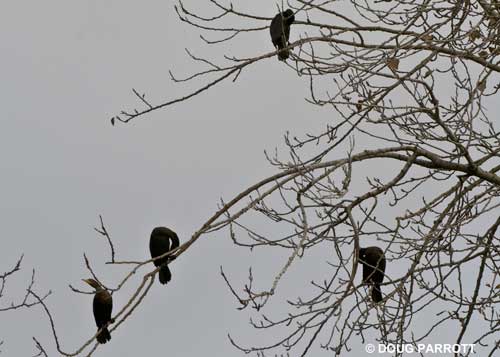
The early cormorant gets the branch—four of the 50-plus Double-crested Cormorants who occupy the cottonwoods at the east end of the Montlake Cut.
Christmas is less than three weeks away, and many people took advantage of last weekend’s dry weather to put up their Christmas lights. It’s a fine show at night, when the lights are turned on.
The Fill is also putting on its Christmas show this week. To see it, though, you have to arrive here at dawn, just before the sun tops the Cascades. Walk down to the canoe rental house at the marina, where the Montlake Cut empties into Union Bay. Face south to take in Mt. Rainier on your left and the tall cottonwoods lining the Cut on your right. Then wait. If conditions are right, you will see a scene unlike any other on the planet.
First, the rising sun—still blocked by the mountains—limns the undersides of the dark clouds with glowing magenta. As the sky grows pinker, the lake becomes red, then molten gold, as though the water had become a sea of lava. Just so must the Columbia Plateau have looked eons ago, when lava covered the earth in fiery waves. In the distance, Mt. Rainier takes on the colors of the sky itself, turning rosy with alpenglow. Above the mountain, Venus glitters in the ice-blue sky, its aspect so clear you can see it as a disk: planet, not star.
Then the sun bursts forth, painting the clouds with streaks of aqua and topaz, indigo, tourmaline and amethyst. A movement catches your eye and you turn to the tall cottonwoods. They are covered from top to toe with Double-crested Cormorants, perched precariously on fragile branches like the world’s ugliest Christmas tree ornaments.
A Bald Eagle glides in from the north over the water with frightening speed. The ornaments spring up from their perches and scatter, each one convinced it is the target of the eagle’s attack. But no, the eagle already has a catch clutched in one foot: a small fish. The eagle lands on a log in the marina and proceeds to dine.
The cormorants circle the feeding eagle and slowly return to their trees. The first ones to come back always seem to be the most skilled at landing. They choose a branch, extend their feet, grab on, flap their tail a little for balance, then fold up their wings, necks, and bodies into black blobs.
Late-comers aren’t so efficient. Some grab branches that are too thin, bending them down almost to the breaking point, and then shooting back up again on them like a diver on a springboard. Sometimes the bird goes flying; sometimes it manages to hold on for dear life until the branch stills. Other late-comers try to usurp an already-occupied branch, hovering in midair like oversized hummingbirds until the branch’s owner snaps at them to drive them away. The branchless cormorants circle the bay and try again, sometimes four or five times.
They’re very persistent, even though they must know that water is their true element, not trees. Webbed feet, after all, are best designed for paddling, not perching. But the cormorants are absolutely determined to join their brethren on the branches. Eventually, every ornament is back in place again, and peace settles over the land.
I’m still ho-ho-ho-ing at the memory.
